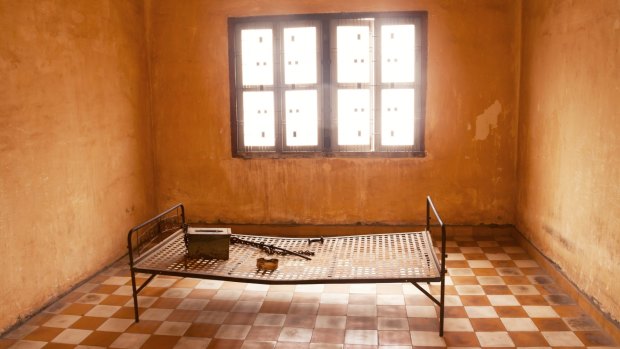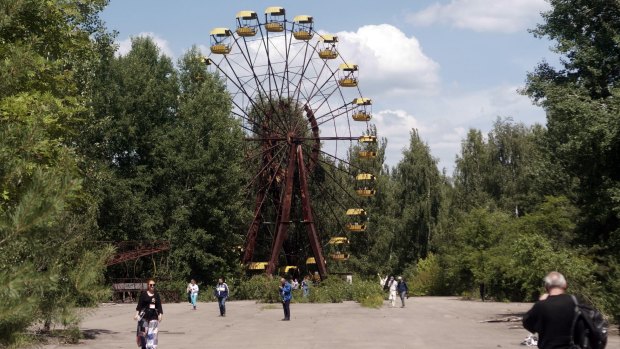This was published 5 years ago
Dark tourism: Why tourists are flocking to the worst places in the world

By Sue Williams
To some, it's a chilling glimpse into the dark heart of humanity and the worst kind of voyeurism.
But to others, it's a vital lesson on what can go frighteningly wrong when maniacs seize power, cast reason and compassion aside and persuade the rest of the world to look the other way. And, of course, as Spanish philosopher George Santayana said, "Those who cannot remember the past" – particularly the bad bits – "are condemned to repeat it".
Dark tourism is today a growing sector of the travel industry, with more travellers taking time out from relaxing on the beach, checking out city sights and exploring nature reserves, to pay homage to horrible histories.

A torture bed in a prison cell at Tuol Sleng (S-21 Prison) in Phnom Penh, Cambodia.Credit: iStock
Yes, it can be gloomy, shocking and depressing but at the same time, comfortingly, there is always some light amid the darkness.
The school in the middle of Cambodia's capital Phnom Penh, for instance, where Pol Pot's murderous Khmer Rouge jailed, interrogated and killed their so-called 'enemies' - up to two million deaths in the four years from 1975 to 1979 - is a sobering place to visit. Yet the individual tales of heroism there in the face of unthinkable terror never fail to inspire.
At the interrogation HQ, code-named S-21 and now known as the Tuol Sleng Genocide Museum, one particular story gleams like a beacon. Among its victims was the remarkable 28-year-old New Zealand yachtie Kerry Hamill, who drifted into Cambodian waters while on holiday in South East Asia, and was picked up by a Khmer patrol boat and accused of being a CIA spy.

The Chernobyl Exclusion Zone, two hours north of the Ukrainian capital Kiev, the 1986 site of the world's worst nuclear disaster.Credit: Bloomberg
He was tortured but somehow managed to keep his sense of humour throughout. When his jailers demanded he name his CIA bosses he told them "Colonel Sanders" of KFC fame and the Beatles' "Captain Pepper", he used his home phone number as his 'operative ID', mentioned family friends as his supposed co-conspirators and, in the most poignant moment, sent a message to his mother Esther by naming an instructor as S.Tarr.
As his younger brother Rob Hamill told a later court hearing into his murder and other atrocities, it was "a message of love and hope. And it was as if, whatever the final outcome, he would have the last say."
But of course the locals suffered on a scale it's almost impossible to comprehend. In the sunny courtyard of what's now the S-21 museum, Bou Meng is sitting behind a desk, selling books about his life. He was mercilessly questioned, tortured and beaten - still bearing savage scars - yet when his jailers discovered he was an artist they demanded he sketch a portrait of Pol Pot.
"That picture, painted as slowly as I could, as well as other portraits of other leaders, ended up saving my life," he tells tourists through an interpreter. "And I make money now from the sale of books. So for me, this place now keeps me going."
There are similar stories of heroism at other shrines to horror. At Ground Zero in New York, I'm taken around by a guide who was there on that fateful day, a former firefighter who was escorting survivors out of one of the Twin Towers when it started to collapse.
Hearing his first-person account and of the courage displayed in the face of so much devastation and death, renews your faith in the resilience of the human spirit.
Over in Africa, Ethiopia had its own dark period. At the Red Terror Martyr's Memorial Museum in the capital Addis Ababa, there are skulls, bloodied clothing, discarded shoes and photos of the dead; some of the 500,000 to 750,000 victims of the Marxist Derg regime which seized power from Haile Selassie in 1974.
The guide on duty the day I visited was simply extraordinary. He too had been held captive and talked about the nightmare he lived through, and even pointed out which twisted methods of torture he'd personally endured. "But those days have long gone," he said at the end with a heart-warming smile. "And thanks to this museum, they will never happen again."
Further south in Rwanda, visitors to the Kigali Genocide Memorial are each given a rose to lay at the burial site of the more than 250,000 Tutsi - out of the total of more than a million who were killed - in the horrific genocide of 1994. It's a simple gesture but it connects you immediately with other mourners, and also to the community-building efforts that have been going on ever since.
Down in South Africa, the world saw one of its most iconic figures rise from the misery that was once the notorious jail on Robben Island off Cape Town.
The late president Nelson Mandela, one of the most admired heroes of the 20th century, was kept here for 18 of the 27 years he was incarcerated before the end of apartheid, and his story of survival is absolutely life-affirming.
Lessons can be learnt too from what must be among the darkest of dark tourist sites. Poland's Auschwitz-Birkenau Memorial and Museum was once the largest of the Nazi concentration and extermination camps where over 1.1 million people lost their lives, and now the worldwide symbol of the Holocaust.
The experience of touring the neat rows of barracks, the old gas chambers and crematorium, and seeing photos of the dead and the suitcases they arrived with, not knowing what awaited them, will stay with me for the rest of my life. Next year the site hosts a series of events marking the 75th anniversary of the camps' liberation.
I was similarly hesitant at first to visit the Atomic Bomb Dome in Japan's Hiroshima that somehow managed to survive the world's first atomic bomb in 1945 and the Hiroshima Peace Memorial Museum, thinking it was going to be just too horrific to face.
But it turned out to be, somehow, an optimistic look at a future where this may never be allowed to happen again. The museum is fabulously done, with both hi-tech vision and simple displays, to educate and to remember the past while acknowledging the beauty of life.
On the nuclear trail, there's also a trip to the Chernobyl Exclusion Zone, two hours north of the Ukrainian capital Kiev, the 1986 site of the world's worst nuclear disaster, which experts predict will eventually lead to around 4,000 cancer deaths.
Today there are a number of tours around the deserted area, with overgrown squares, empty homes, an abandoned kindergarten, derelict blocks of flats and a sobering reminder of what can happen when our brave new world of technology is blighted by human error.
Mistake or human stupidity? The War Remnants Museum in Ho Chi Minh City is dedicated to the memory of both the Vietnam War – they call it the 'American' War – and the first Indochina War against the French.
There are some eye-watering exhibitions of torture apparatus used on the opponents of the old US-backed South Vietnamese Government, as well as captured American planes and helicopters, a display about the horror birth defects caused by the use of Agent Orange and an incredible gallery of press photos.
The propaganda has been toned down, however, in recent years, probably because nowadays there are so many US and Australian visitors.
But dark tourism is not only about man's inhumanity to man. There's also a huge appetite today for gazing at the devastation of nature. In Pompeii, Italy, there's the ruins of the ancient Roman city – and its fossilised inhabitants – following the catastrophic eruption of Vesuvius in 79AD. Today, the city blanketed in a tide of ash and lava is the most visited archaeological site in the world.
Each memorial to such human tragedy is certainly painful to view, yet how much more terrible would it be for that suffering to be forgotten, and then for it all to be in vain?
For you can only drive out darkness by bringing in the light. And by making sure people know the consequences when not enough care.
S-21 Cambodia, see tuolsleng.gov.kh/en/; Ground Zero, New York, see 911groundzero.com; The Red Terror Martyr's Memorial Museum, Ethiopia, see rtmmm.org; Kigali Genocide Memorial, Rwanda, see kgm.rw; Robben Island, Cape Town, South Africa, see robben-island.org.za; Auschwitz-Birkenau Memorial and Museum, Poland, see auschwitz.org/en; Hiroshima, Japan, see visithiroshima.net; Chernobyl Exclusion Zone, Ukraine, see chernobyl-tour.com/English; War Remnants Museum, Ho Chi Minh City, Vietnam, see baotangchungtichchientranh.vn; Pompeii, Italy, see visitpompeiivesuvius.com
See also: Beware the dust: Warning as tourists flock to Chernobyl
Sign up for the Traveller newsletter
The latest travel news, tips and inspiration delivered to your inbox. Sign up now.
